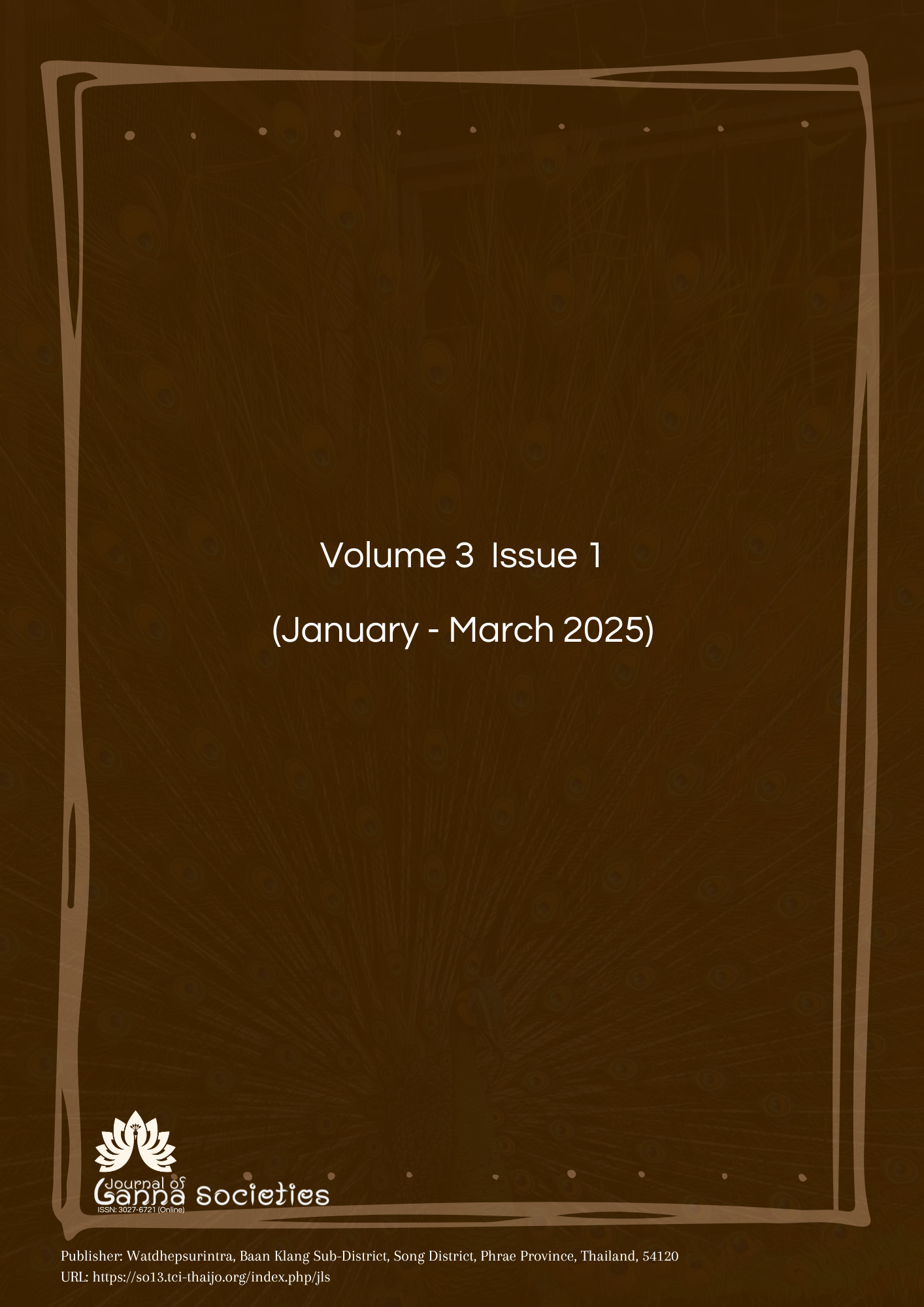Application of the principle of Aparihāniyadhamma to promote public participation in preventing and solving drug problem at Nampai Subdistrict in Maecharim District of Nan Province
Keywords:
Participation, Aparihāniyadhamma, DrugAbstract
This thematic paper has 3 objectives: 1. To study the level of public participation in preventing and solving drug problems in Nam Pai Subdistrict, Mae Charim District, Nan Province; 2. To study the relationship between the Aparihāniyadhamma principle and public participation in preventing and solving drug problems in Nam Pai Sub-district, Mae Charim District, Nan Province; 3. To present the guidelines for applying the Aparihāniyadhamma principle to promote public participation in preventing and solving drug problems in Nam Pai Subdistrict, Mae Charim District, Nan Province. This is
mixed-method research, which is quantitative survey research with a sample of 324 people. Data were analyzed by finding the frequency, percentage, mean, and standard deviation, and analyzing the relationship between public participation and the application of the Aparihāniyadhamma principle to promote public participation in preventing and solving drug problems in Nam Pai Sub-district, Mae Charim District, Nan Province by finding Pearson’s product-moment correlation coefficient. Qualitative research was conducted by conducting in-depth interviews with 13 key informants using the content analysis technique with context. The research was presented as an essay with a frequency distribution table of key informants to support the quantitative data.
The Research findings show that:
- The level of public participation in preventing and solving drug problems in Nam Pai Subdistrict, Mae Charim District, Nan Province, overall, was at a low level (
= 2.21 S.D. = 0.65). When considering each aspect, it was found that participation in decision-making, participation in operations, participation in receiving benefits, and participation in evaluation were all at a low level.
- The relationship between the Aparihāniyadhamma principle and public participation in preventing and solving drug problems in Nam Pai Subdistrict, Mae Charim District, Nan Province, overall, found that there was a very small positive relationship (R = 0.087). From the hypothesis testing, it was found that the Aparihāniyadhamma principle had no relationship with public participation, so the hypothesis was rejected.
- Guidelines for applying the Aparihāniyadhamma principle to promote public participation in preventing and solving drug problems in Nam Pai Sub-district, Mae Charim District, Nan Province, found that relevant government agencies should study the factors promoting public participation in preventing and solving drug problems in the area to develop more public participation and government agencies in all sectors. Guidelines or processes for implementing policies promoting public participation in results-oriented practices, studying sustainable development guidelines for public participation in preventing and solving drug problems in the area, and having greater diversity in developing models for promoting public participation integrating Buddha Dhamma principles that are appropriate for the area. Other research methods should also be considered to develop models for applying the Aparihāniyadhamma principle to promote public participation in preventing and solving drug problems in the area to be more effective.
References
ทักษิณ ประชามอญ. (2560). รูปแบบการบริหารงานแบบมีส่วนร่วมตามหลักพุทธธรรมขององค์การบริหารส่วนจังหวัด ในกลุ่มจังหวัดภาคตะวันออกเฉียงเหนือตอนบน. ดุษฎีนิพนธ์พุทธศาสตรดุษฎีบัณฑิตสาขาวิชารัฐประศาสนศาสตร์. บัณฑิตวิทยาลัย : มหาวิทยาลัยมหาจุฬาลงกรณราชวิทยาลัย.
ทัศนีย์ ปิยะเจริญเดช. (2564). รูปแบบการพัฒนาการจัดการการท่องเที่ยวบนพื้นที่เศรษฐกิจพิเศษในจังหวัดสงขลา. ดุษฎีนิพนธ์ปริญญาปรัชญาดุษฎีบัณฑิต สาขาวิชารัฐประศาสนศาสตร์ .บัณฑิตวิทยาลัย : มหาวิทยาลัยมหาจุฬาลงกรณราชวิทยาลัย.
พระมหาอากาย ฐิตธมฺโม (ผดุงชาติ). (2563). การมีส่วนร่วมของประชาชนในการบริหารเพื่อสร้างชุมชนเข้มแข็งขององค์การ บริหารส่วนตำบลกุดลาด อำเภอเมือง จังหวัดอุบลราชธานี. วิทยานิพนธ์ปริญญารัฐประศาสนศาสตรมหาบัณฑิต. บัณฑิตวิทยาลัย : มหาวิทยาลัยมหาจุฬาลงกรณราชวิทยาลัย.
พระราชบัญญัติยาเสพติดให้โทษ พ.ศ. 2522 มาตรา 7.(2561).[ออนไลน์]แหล่งที่มา: http://web.
krisdika.go.th/data/law/law2/ %C207/%C207-20-9999-update.pdf
พีรพล ไชยณรงค์ศักดิ์. (2562). ประสิทธิผลการดำเนินงานตามแผนพัฒนาท้องถิ่นขององค์การบริหารส่วนตำบลบ้านใหม่ อำเภอหนองบุญมาก จังหวัดนครราชสีมา. สารนิพนธ์รัฐประศาสนศาสตรมหาบัณฑิต .บัณฑิตวิทยาลัย : มหาวิทยาลัยมหาจุฬาลงกรณราชวิทยาลัย.
ภิสรินธันญ์ อนุคุต. (2566). การมีส่วนร่วมของประชาชนในการส่งเสริมการท่องเที่ยวเชิงอนุรักษ์ขององค์การบริหารส่วนตำบลฝายแก้ว อำเภอภูเพียง จังหวัดน่าน. สารนิพนธ์รัฐประศาสนศาสตรมหาบัณฑิต.บัณฑิตวิทยาลัย : มหาวิทยาลัยมหาจุฬาลงกรณราชวิทยาลัย.
มนตรี อินน้อย. (2566). การมีส่วนร่วมของประชาชนในการแก้ไขปัญหาอุทกภัย ขององค์การบริหารส่วนตำบลม่วงตึ๊ด อำเภอภูเพียง จังหวัดน่าน. สารนิพนธ์รัฐประศาสนศาสตรมหาบัณฑิต.บัณฑิตวิทยาลัย : มหาวิทยาลัยมหาจุฬาลงกรณราชวิทยาลัย.
วิภาส ทองสุทธิ์. (2551). การบริหารจัดการที่ดี. กรุงเทพมหานคร : สำนักพิมพ์อินทภาษ.
Cohen John M. & Norman T. Uphoff. (1980). Participation’s Place in Rural Development: Seeking Clarity Through Specificity. World Development.
Downloads
Published
How to Cite
Issue
Section
License
Copyright (c) 2025 Journal of Lanna Societies

This work is licensed under a Creative Commons Attribution-NonCommercial-NoDerivatives 4.0 International License.




